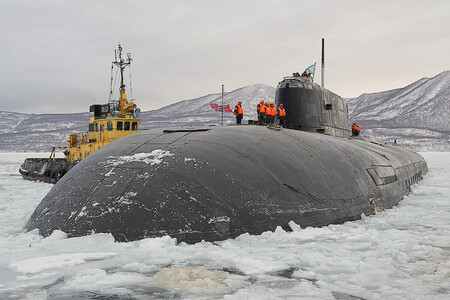There is no kingdom that lasts forever. Not even that of one of the most fearsome and fascinating devices in naval history. After having survived the Cold Warto the dissolution of the USSR and to the 20th century itself that saw it born, after having even served as a Hollywood inspiration, the Dmitry Donskoy submarine, the once warlike jewel of the Kremlin, faces its final chapter. The Russian Navy has decided to decommission him and send him to the Severdvinsk naval base, in the White Sea, where he has reunited with two of his old brothers, all of the 941 Akula class, also known by the nickname assigned to them by the NATO in its day: the Typhoons.
What exactly is the Dmitry Donskoy? And why is his discharge from the Russian Navy so much more than a mere administrative procedure or a war curiosity?
A heritage from the USSR. The Dmitry Donskoy is the legacy of an era perhaps not so distant in time, but certainly in terms of milestones: it was manufactured in the Sevmash shipyard in 1976during the Cold War, and ended up being launched in 1980.
In its day, its premiere was also much more than a simple war process: with Dmitry Donskoy and the rest of his five brothers, all from the 941 Akula class, the USSR wanted to muscle up before the world. And the truth is that he did not do badly. The Akula —or Typhoom, the name assigned to it by NATO— measured 23 meters wide and more than 170 meters long and were equipped with modern weapons.
The K-150, Oscar II class submarine.
A unique submarine. The Dmitry Donskoy stands out for its technical characteristics. And because of his peculiar war history. The USSR came to launch six submarines of the Akula-class, to which is added one that could not be completed. Curiously, of all of them, the one that has continued to make headlines until not long ago is also the oldest: the TK-208, better known as Dimitry Donskoy.
Although the veteran Akula was launched in 1980, years before his brothers, he has continued to be considered active until practically the day before yesterday. The rest were terminated or ended up scrapped or inactive between the 1990s and the 2000s. The longevity of the Dmitry Donskoy is due to the fact that in 2002 it was upgraded under the 941UM project and later used to test the Bulava missile. In the summer of 2017 the old Akula-class submersible still sailed to the Baltic Fleet
And how is the Dmitry Donskoy? Big. So much so that in the 90s Guinness World Records named the Akula as the biggest submarines of the world. accurate naval news that the Dmitry Donskoy (TK-208) measures 170×23.3 m and displaces 48,000 tons submerged, although some people attributes to him a size somewhat larger.
Although its size is considerable and exceeded that of many of the battleships of World War II, the record was snatched not so long ago. Today the submarine shades him K-329 Belgoroda nuclear submersible with a longer hull, a fact that some raise above 180 meters .

A retirement… unexpected? in 2021 TASS agencybased in Moscow, assured that Dmitry Donskoy would continue to be active until at least 2026. Although he did not identify them, his sources were from the military and they stated emphatically: “The dismantling of the submarine is a matter of five years, at least.” A few days ago TASS gave however quite different information: the Russian Navy has decided to decommission its veteran submersible.
And now that? “The Dmitry Donskoy submarine cruiser has been withdrawn from Navy service. It will await utilization at a Severodvinsk naval base together with two other units of this project,” explained to the agency state the head of the Russian Army Support Movement, Vladimir Maltsev. As for the rest of the Akula veterans, he says, three have been scrapped and two, Arkhangelsk and Severstal, have been withdrawn from service and await disposal.
For its dismantling —precise Naval News— It is necessary to first remove the nuclear reactors, the rest of the installation and finally to scrap the steel structure. The end of Dmitry Donskoy marks a historic milestone, but it is not unexpected news: months ago, last summer, the agency RIA Novosti was already advancing which had been withdrawn from the fleet and later dismantled.
A new jewel in the crown. The retirement of the Dmitry Donskoy does not come as a surprise to the Russian Navy, which for months has already had a worthy successor: the Belgorod, 184 m long and 18.2 wide, capable of accommodating a crew of 130 people, Equipped with two nuclear reactors with a capacity of 190 MW and an immersion displacement capacity of 30,000 tons.
On board is a Bester DSRV mini-submersible and another 60-meter long Losharick, as well as six poseidon torpedoesprojectiles that can be around 20 meters long and, according to USNI News, can be armed with a warhead of up to 100 megatonswhich gives it great destructive power.
Images: Ministry of Defense of the Russian Federation 1 and 2



![[Img #74693]](https://thelatestnews.world/wp-content/uploads/2024/12/Give-a-second-life-to-your-mobile-with-iLevante-150x150.jpg)






![[Img #74693]](https://thelatestnews.world/wp-content/uploads/2024/12/Give-a-second-life-to-your-mobile-with-iLevante-300x200.jpg)
